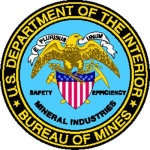- Branche: Mining
- Number of terms: 33118
- Number of blossaries: 0
- Company Profile:
The U.S. Bureau of Mines (USBM) was the primary United States Government agency conducting scientific research and disseminating information on the extraction, processing, use, and conservation of mineral resources.
Founded on May 16, 1910, through the Organic Act (Public Law 179), USBM's missions ...
A dark, dense limestone containing abundant organic matter, believed to have accumulated under stagnant conditions and emitting a fetid odor when freshly broken or vigorously rubbed; e.g., the Bone Spring Limestone of Permian age in west Texas.
Industry:Mining
A dark, translucent massive or coarsely crystalline variety of nepheline; greasy luster; may be used as an ornamental stone. Also spelled: elaeolite; elaolite.
Industry:Mining
A dark-brown to black residuum from the distillation of coal tar, ranging from a sticky mass to a brittle solid, depending on the degree of distillation. Most coal-tar pitch melts between 60 degrees C and 70 degrees C.
Industry:Mining
A dark-colored intrusive rock composed of alkali feldspar, labradorite, pyroxene, biotite, iron oxides, apatite, and possibly a small amount of nepheline. It is essentially a monzonite. Its name, given by Johannsen in 1938, is derived from the Highwood Mountains, MT. Not recommended usage.
Industry:Mining
A dark-colored plutonic rock that is part of the ijolite series and contains nepheline and 60% to 90% mafic minerals, esp. green pyroxene. The name is from Melteig farm, Fen complex, Norway.
Industry:Mining
A dark-colored syenite composed chiefly of augite and alkali feldspar, and possibly containing olivine, hornblende, biotite, and nepheline. Its name, given by Weed and Pirsson in 1895, is derived from Shonkin, the Indian name for the Highwood Mountains of Montana.
Industry:Mining
A dark-colored, fine-grained extrusive rock that, when porphyritic, contains phenocrysts composed primarily of zoned sodic plagioclase (esp. andesine) and one or more of the mafic minerals (e.g., biotite, hornblende, pyroxene), with a groundmass composed generally of the same minerals as the phenocrysts, although the plagioclase may be more sodic, and quartz is generally present; the extrusive equivalent of diorite. Andesite grades into latite with increasing alkali feldspar content, and into dacite with more alkali feldspar and quartz. It was named by Buch in 1826 from the Andes Mountains, South America.
Industry:Mining
